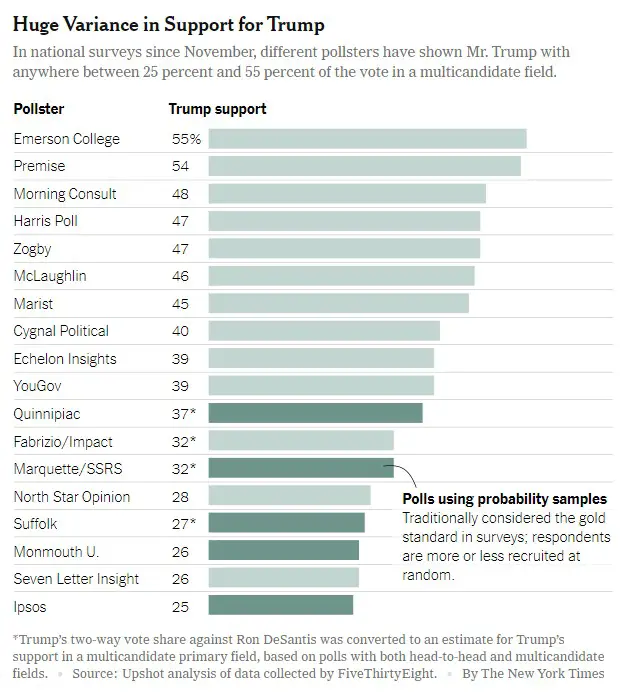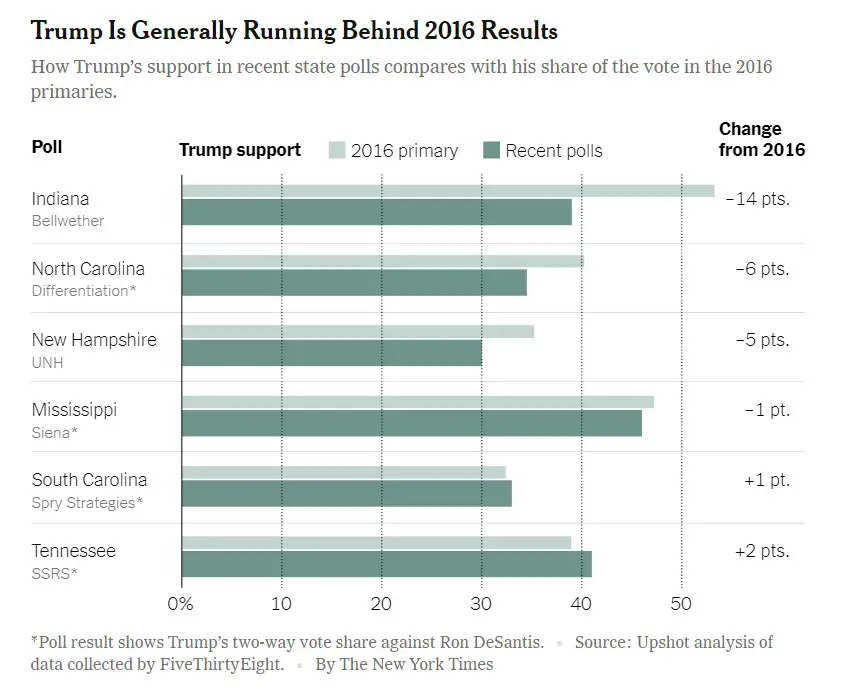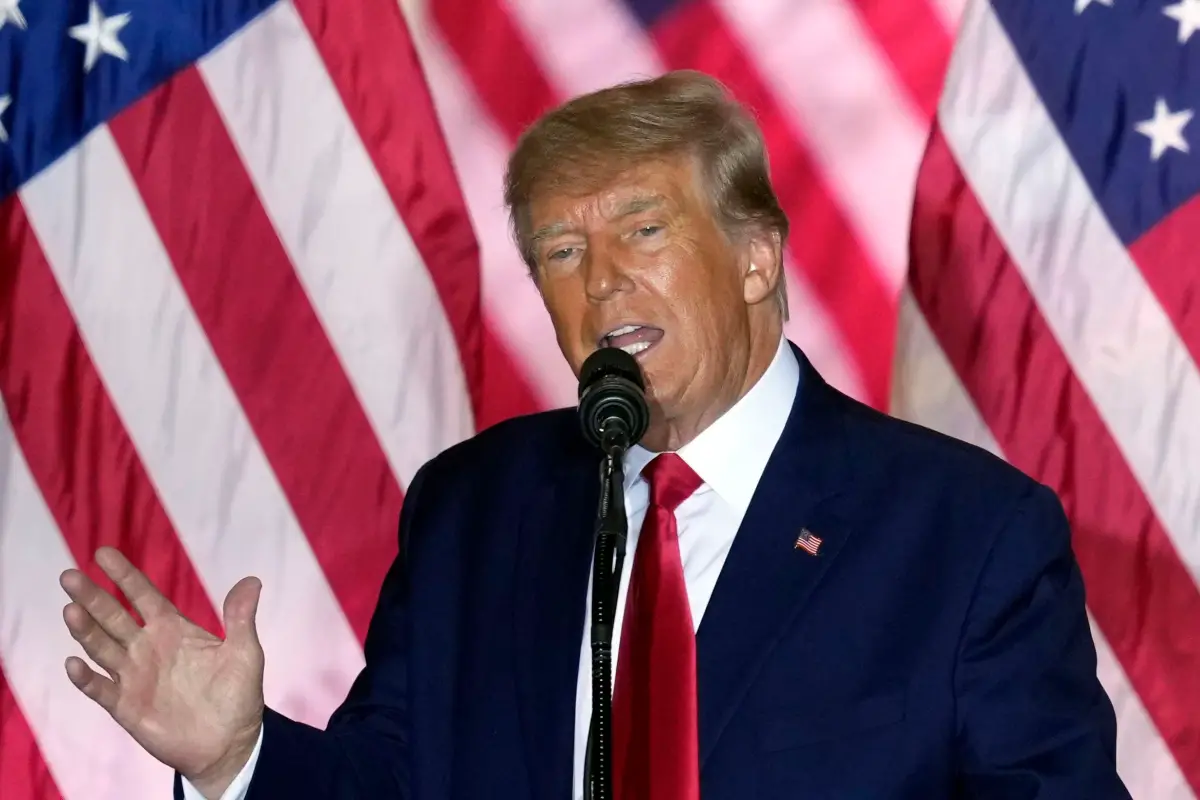No shocker here, it’s early in the process.
With that being said, there’s a clear pattern emerging among early 2024 GOP primary polls. Yes, we’ve established that polling in recent cycles is all over the map and isn’t worth betting the farm on. Why it matters right now, however, is that early primary polls tend to affect the behavior of potential candidates. If the so-called front-runner isn’t as strong as everyone previously thought, it might open the spigot for more candidates to get in the race.
Analyzing dozens of polls for the New York Times, Nate Cohn has spotted a pattern that demonstrates a massive difference in support for former President Donald Trump depending on the polling source. The gist of the analysis is that you can basically cherry-pick whichever polls support your preferred candidate and discount the rest.
As Cohn explains, Trump’s either the outright clear favorite for the 2024 nomination or he’s actually struggling to consolidate support:
Is Donald J. Trump the clear favorite and front-runner to win the Republican nomination? Or is he badly weakened and even an underdog against Ron DeSantis?
At the onset of the Republican campaign, the polls are exceptionally divided on Mr. Trump’s support among Republican primary voters.
In national surveys since last November’s midterm election, different pollsters have shown him with anywhere between 25 percent and 55 percent of the vote in a multicandidate field.
That’s right: a mere 30-point gap.
Here’s an accompanying chart compiled by Cohn that illustrates the vast difference in polling data:
 If you believe Ipsos, which finds Trump with just 25% support of primary voters, you’d conclude he’s far weaker than he was in 2016. If you pay attention to Emerson College or Morning Consult, on the other hand, Trump appears to have the backing of roughly half the party, a dominant position that easily cements him as the front-runner in 2024.
If you believe Ipsos, which finds Trump with just 25% support of primary voters, you’d conclude he’s far weaker than he was in 2016. If you pay attention to Emerson College or Morning Consult, on the other hand, Trump appears to have the backing of roughly half the party, a dominant position that easily cements him as the front-runner in 2024.
The truth is likely somewhere in between but it speaks to the ridiculous variance in polling models and the over-saturation of bad data that infects our modern politics.
As Cohn further explains, with polling data all over the map, the signal-to-noise ratio heading into this primary season might be higher than any previous cycle:
Whether Mr. Trump is at 25 percent or 55 percent is no small matter. Believe it or not, early polling is fairly predictive of the eventual outcome in presidential primaries. It also has real-world consequences. It affects the decision-making of potential candidates, operatives and activists, many of whom have adopted a wait-and-see approach in part because there are so many conflicting signs of Mr. Trump’s strength.
And the existence of such a wide split betrays that the survey research industry may be in far worse shape than one might have otherwise guessed. While the exact reason for the vast spread in survey results is hard to ascertain, the likeliest explanation is that many well-known pollsters are collecting profoundly unrepresentative data.
Although there’s not a clear picture, a rough pattern in the data might hint at the actual state of the race. Higher-quality surveys have tended to show far less support for Mr. Trump.
Cohn also goes on to hypothesize that there are vastly different groups of Republicans within any given sample. There are the ardently pro-Trump Republicans that will always pick their preference no matter what. Then there are samples that could be less Trump-friendly resulting in softer Trump support. In other words, if you pick two groups of voters that identify themselves as Republicans, you might get a very pro-Trump group or a very never-Trump group, or somewhere in between.
On the top line, it looks like you sampled 500 or 1,000 Republicans but the type of Republicans within that group can differ widely given Trump’s level of polarization. People either love him or hate him, there’s little room in between.
Perhaps the best way to try and compare apples to apples is to look at polls from this cycle versus polls in 2016, the last time Republicans had an open primary:
 By these numbers, Trump is running slightly behind where he was during the 2016 GOP primary. That doesn’t mean it’ll stay this way, Trump is still mostly in the driver’s seat and could start rekindling his 2016 coalition within the rank-and-file of Republican primary voters once the process gets underway. Again, it’s early in the process.
By these numbers, Trump is running slightly behind where he was during the 2016 GOP primary. That doesn’t mean it’ll stay this way, Trump is still mostly in the driver’s seat and could start rekindling his 2016 coalition within the rank-and-file of Republican primary voters once the process gets underway. Again, it’s early in the process.
There are two main conclusions I’m taking from this analysis.
First, there is too much polling data with too much noise. A 30-point gap means someone’s wrong or nearly everyone is wrong. The variance in poll numbers is what created the space for polling averages, like RealClearPolitics, to try and make sense of the data. But even if you average numbers bad numbers, you’re stuck with the garbage-in/garbage-out principle.
Second, Trump’s not as strong as he was but not as weak as some would claim. Stories about how his grip is loosening on the GOP are somewhat true but not wholly true. From this vantage point, it looks like voters want to see the new menu in 2024 before they make a selection. There are new names that weren’t on the scene back in 2015-2016 and they want to hear from all of them before lining up behind a candidate.
There’s plenty of noise right now to sift through. As the weeks go by and the 2024 primary gets rolling, the picture should become less fuzzy.
Donate Now to Support Election Central
- Help defend independent journalism
- Directly support this website and our efforts
